Found family: DNA test solves a mystery and brings unknown relatives together
| Published: 09-06-2022 9:01 PM |
Jane Carlton Verdrager was 3 years old when her father vanished.
Douglas Carlton was a butcher and meat salesman who worked for the City Packing Co., in Wayne, Mich., 30 miles west of Detroit. On the day he disappeared, he’d been doing his regular delivery run to small grocery stores and households. Nothing out of the ordinary, except that he never came home. The next day, Aug. 5, 1949, Verdrager’s mother, Arlene Carlton, six months pregnant and 26 years old, reported to the police that her husband of six years was missing.
Douglas Carlton was 23, blue-eyed and blond-haired, approximately 5 feet, 10 inches tall and around 175 pounds, according to a story in the Aug. 17 Detroit Free Press. He wore glasses. The company truck he’d been driving was later found in Detroit. Residents of the neighborhood had seen a short, dark-haired man walking away from the truck, but that description did not match Carlton. Also missing was approximately $2,000 that Carlton had collected on his route. A warrant was issued for his arrest on the charge of embezzlement.
Carlton had been an inveterate gambler. He’d frequented a “blind pig,” Detroit slang for a speakeasy or illegal gambling operation, that was run by a paternal uncle right across the street from Carlton’s house. He’d also amassed large debts. The family’s assumption was that the Detroit mob had killed him, but there was no trail of evidence. A statewide hunt turned up nothing. All inquiries hit dead ends.
In the years that followed, Carlton’s family — parents and brother, wife and children — struggled to understand what had happened.
“He left everybody. Everybody,” said Verdrager, 76, a retired educator who lives in Eastman in Grantham.
Seven years after her husband’s disappearance, Arlene Carlton petitioned the state of Michigan to have him declared legally dead.
When Jane Verdrager was 12, her paternal grandmother told her, “Janie, I just know your father has to be dead; he never could have stayed away.”
Article continues after...
Yesterday's Most Read Articles
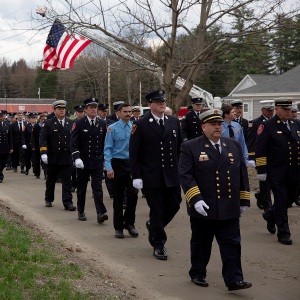 Crowd turns out to honor late Ascutney Fire Chief Darrin Spaulding
Crowd turns out to honor late Ascutney Fire Chief Darrin Spaulding
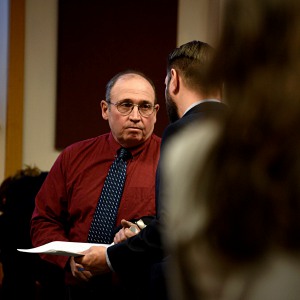 Former principal of South Royalton School released from prison
Former principal of South Royalton School released from prison
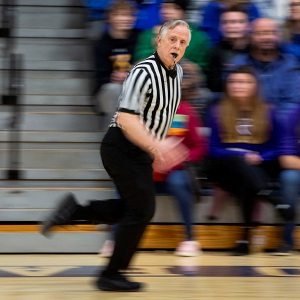 Pick a sport and Pete DePalo’s has probably officiated it over the past 40-plus years
Pick a sport and Pete DePalo’s has probably officiated it over the past 40-plus years
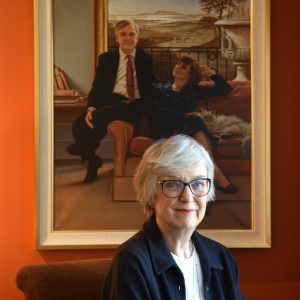 Upper Valley residents among advocates for NH aid-in-dying bill
Upper Valley residents among advocates for NH aid-in-dying bill
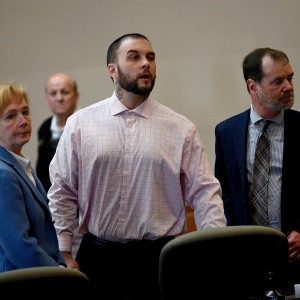 NH man convicted of killing daughter, 5, ordered to be at sentencing after skipping trial
NH man convicted of killing daughter, 5, ordered to be at sentencing after skipping trial
“This was always the mystery,” Verdrager said.
Verdrager had long assumed that the puzzle might never be solved, until this summer, when pieces began to fall into place.
There was also a mystery at the heart of the Nelson family. Donna Nelson Woods, 68, had long been curious about her father’s history. Donald Nelson never discussed his background. He’d told his wife Frances and their five children that his parents had died in a car accident and his brother had been killed in a motorcycle crash.
Yes, sometimes her father’s answers to questions about his childhood were vague, and, yes, sometimes his responses differed slightly. But the family “took whatever he said for granted. We all did,” Woods said.
The Nelson family lived outside Cincinnati. Their life was not luxurious but they were a close family. Donald and Frances worked hard to send the kids to parochial schools.
Yet, a gnawing uncertainty ate at Woods. Her mother had told her that, prior to marrying Nelson, her mother’s sister Helen had said bluntly, “Why do you want to marry him? You know nothing about him. He doesn’t have any kind of family or anything.”
The facts, according to Donald Nelson, were these: He’d left his home state of Michigan and traveled to Cincinnati. He’d stayed in Cincinnati because a pickpocket had stolen $200 from him. In order to recoup that loss, he’d stayed in the city to look for work. A local family had taken him in, and he’d found a job as a butcher at a meat market. The owner of the meat market told Donald Nelson that he should date young Frances Zahorchak, who was a regular customer. They eventually married in November 1950.
As Woods got older, she said, the gaps in her father’s story “kind of stuck in my craw. I thought, Hmm, there might be something to what Aunt Helen told my mother.”
Woods’ father had said he’d been born in Michigan in 1927. But when she looked in the state records for the birth certificate, she couldn’t find it. Woods, who works at International Paper’s Technology Center in Loveland, Ohio, then consulted an engineer she worked with, Glen Gallagher, who was immersed in genealogical research.
“ ‘Will you help me find my dad?’ ” Woods recalled asking him. “And he said, ‘Sure.’ ”
That was in 2007. But Gallagher had no more luck than she’d had.
Kamee Verdrager, an attorney in Bedford, N.H., had peppered her mother, Jane, with questions since she was young. Like Woods, Kamee Verdrager felt that there were huge gaps in the family story. Why would Carlton abruptly abandon his family? What if he’d disappeared to protect them from the mob? Didn’t her mother want to know what happened?
Jane Verdrager had not contemplated a full-fledged investigation. “Never,” she said.
Something held her back: “As a child I learned not to question, I didn’t rock the boat. So I just accepted it. It was tough. My mother was, I’m sure, traumatized, but she was also somebody that you didn’t question.”
In recent years, Verdrager said, her daughter had tried to cajole her into shaking the family tree: “ ‘You never know, Mom. You could have another family out there ...’ I’d say, ‘Come on!’ ”
Kamee was not deterred. In 2019, she gave her mother a kit from 23andMe, a DNA testing company, as a Christmas present. (The name alludes to the 23 pairs of chromosomes in human DNA.)
“To tell you the truth I was a little disappointed in my Christmas gift,” Jane Verdrager said with a chuckle. But to satisfy her daughter, she sent a DNA sample to 23andMe. Other than finding a distant relative, the test didn’t yield anything significant that would point to her father.
Not ready to give up, Kamee turned to the genealogical website Ancestry.com to take her own DNA test. She also entered the names of her parents and grandparents in her Ancestry family tree. When she looked at the subsequent matches, in 2020, “there wasn’t anything very compelling,” she said.
This spring, Gallagher, now retired, again took up the mystery of Donald Nelson. He’d mentioned to Woods, he wrote in an email, that the “the next promising opportunity for a clue would be the release of the 1950 census records.” The U.S. Census, which is carried out every decade, is made publicly available after 72 years. The 1950 census was released this April.
Sure enough, Donald Nelson showed up, listed as living with a family in Cincinnati. This only added to the confusion because he was identified as a nephew. As far as the Nelsons and Gallagher knew, he didn’t have any other relatives.
At which point, Woods recalled, Gallagher told her “the only way we can really find out anything is if you do a DNA test.”
“I was reluctant, I’m older but then I thought, ‘OK, do it.’ So I did it,” she said.
Her brother Bill, the youngest of the five Nelson children, was also hesitant: “I was the one who said, ‘Why do you keep doing this? It could crush you.’ ”
“Bill loved his father. He doesn’t want anything negative to be said about his father, and I don’t either,” Woods said.
Woods remembers thinking that if Gallagher was able to track down her father through her DNA profile that the likeliest explanation for the discrepancies was that her father had been adopted and his name changed. Once Woods’ DNA profile came back, Gallagher began to dig. When he found a match with Kamee Verdrager, he asked Woods whether she wanted him to contact Kamee. She said yes.
On July 24, Kamee Verdrager received out of the blue an email from Gallagher. He informed her that when he compared Donna Woods’ DNA with Kamee’s, it was obvious that they had to be closely related, because of the high percentage of DNA markers they shared. There were a few possible explanations: either Kamee was Donna’s granddaughter. Or, more likely, Kamee was Woods’ half-niece.
Donald Nelson, Donna’s father, also had to be very closely related to Kamee’s grandfather, Douglas Carlton. But Gallagher couldn’t determine precisely how Carlton and Nelson fit together. When Kamee read the email, she told her mother that this was the discovery they’d been waiting for all these years.
“Um, Mom, I think I found your sister,” Kamee Verdrager said, as she walked her mother through the DNA results, comparing the high correlation of DNA markers between Donna and Kamee to the lower correlation of DNA markers with other Verdrager relatives.
Kamee asked her mother what she wanted to do. Hold off or make contact? “Proceed,” her mother said.
Kamee Verdrager responded to Gallagher immediately.
“I just knew,” she said. “My percent match with Donna was more than double the other (family tree) matches. So that cemented it. There was not a single doubt in my mind” that her grandfather Douglas Carlton and Donna’s father were the same person.
Gallagher searched the 1950 census again. Yes, there was a Douglas Carlton listed in Michigan. Oddly, Carlton and Nelson had the same birthdate but Carlton had been born in 1926 while Nelson had said he’d been born in 1927. Then Gallagher spotted a crucial clue at the bottom of the page. An addendum read that Carlton had been missing for a year. That sent Gallagher to newspaper archives, where he found the Detroit Free Press article with the accompanying photo.
When he emailed the story and photo to Donna Woods, her response was, “That’s my dad.”
It was the same photograph held by the Carlton family for years, and which Jane Verdrager has kept all her life as a memento.
When Gallagher told Woods that Jane Verdrager was interested in making contact, Woods called.
“We had a long, long, long conversation. There have been lots of tears in the past few weeks,” Woods said.
Woods told Verdrager that, if the process of discovery proved too painful, they didn’t have to go any further.
“I said, no, no, I welcome the contact,” Verdrager said. “You deal with things on two levels: on an intellectual level, which you can reason out and rationalize in all the right ways. But then there’s the emotional level ... it’s just an unpredictable reaction.”
There was discussion of Jane Verdrager going out to Ohio to meet the Nelsons. But she demurred.
“I called Donna and said, ‘You can’t drop this bomb on them and then have me come out from behind the curtain.’ ” she recalled.
Woods then called a family meeting in late July and broke the news. She told Verdrager to expect a follow-up call from her between 7 and 7:30 p.m.
“I’m sitting here drumming my fingers on the table and it’s a quarter to eight and I’m thinking, Oh, this didn’t go well. And then the phone rang,” Verdrager said.
On Thursday Aug. 11, Donna Nelson Woods flew into Boston and took a Dartmouth Coach bus to New London, where Verdrager met her. Woods was apprehensive, she said.
“What if she’s not there? What if she is not who she says she is? I took a big chance and she took a big chance,” she said.
The next day, Donna’s brother Bill Nelson, sister Mary Nelson Boelleke and Donna’s daughter Autumn Hamberg, arrived at Verdrager’s home after a two-day drive from Loveland, Ohio. Kamee was also there. Not all the siblings had come: Jane Verdrager’s younger sister Janice did not attend; nor did one of the Nelson sisters.
“We’re all stumbling,” said Donna Woods, sitting at a table in Jane Verdrager’s backyard, where the families had gathered. Old photographs, file folders, photo albums, newspaper articles and police reports covered the table. The families exchanged information and theories, and closely examined faded black-and-white family snapshots. There seemed to be physical resemblances. Similar noses, something in the set of the eyes, maybe the smiles.
It was hard to break old habits. “I keep saying my Dad, and their Dad,” Verdrager said.
“The story is hard for me to believe because of the way he treated and cared for us,” Bill Nelson said.
The unanswered questions are numerous. Did someone assist Douglas Carlton in leaving Michigan? Did Carlton already have a living situation set up in Cincinnati? Verdrager thinks it is likely.
“I’m convinced this was arranged; he had help, he knew where he was going,” she said.
Mary Nelson Boelleke nodded. “He had to have had help.”
What drove Douglas Carlton to leave? “I keep trying to put myself in his shoes,” Verdrager said. One explanation might be that her parents, who married young, didn’t have a good marriage.
Carlton had lied on the marriage license, saying he was 19 when he was only 17; Arlene was shy of 20. The fact that Jane was born three years after their marriage would seem to squelch any speculation that Arlene was already pregnant when she married. Once Carlton had left, conditions for Arlene Carlton and her two daughters were tough, Verdrager said.
Initially her mother wasn’t employed. However, because she had a house, she was not eligible for welfare. Yet she couldn’t sell the house because there was no husband to sign off on a sale. So with the help of her family, Arlene Carlton restructured the house so she could rent it out. She and her two daughters moved into the basement. Living conditions were spartan. Arlene eventually found work, most likely in one of the automobile factories integral to the Detroit economy, Verdrager said. When Jane’s younger sister Janice was an infant, she was boarded out during the week; Jane shuttled among relatives while their mother worked.
Their mother, Verdrager said, was volatile and angry.
“As I was growing up, I would count the years till I could get out. Sometimes I would cry at night and fantasize about my father showing up and rescuing me,” Verdrager said.
One of the first questions that Verdrager put to Woods when they began talking in July was, “Was he a good dad?” And Woods replied, Yes, he was a very good dad.
“And that was comforting to me. That was comforting,” Verdrager said.
Douglas Carlton left his first family behind in Michigan, but he did not forget them. When he and Frances applied for a marriage license, Carlton gave his mother’s name as Marjorie Jane Carter, using both his mother’s and daughter’s first names, and substituting for Carlton the very similar name Carter.
When it came time to name the first Nelson son (who has since died), he gave him the middle name Patrick, or Pat — which was the name his younger brother Lawrence Carlton went by. One of the Nelson daughters is called Marjorie Anne; Anne is Jane Verdrager’s middle name.
Whether Carlton/Nelson knew that Arlene had also given birth to Janice is unknown. The Nelsons say that their father used to go back to Michigan for fishing trips, near where he grew up. Perhaps he gleaned information then.
“He must have lived with a lot of remorse and guilt. Otherwise why would he be using the names?” Woods said.
“Conflict, that’s what that suggests to me,” Verdrager said. “I think that validates that he really was a good person. Maybe he wasn’t when he was 19 or 20. ... But he made a good life for himself and his family. I just wish it had been for me.”
There are other leads the family wants to pursue. Finding descendents of the family with whom Carlton roomed in Cincinnati; tracking down Carlton/Nelson’s Social Security numbers; tracing the dark-haired man seen leaving Carlton’s truck; and looking through the digitized records of other Michigan and Cincinnati newspapers.
With the support of her paternal grandparents, Verdrager went to Western Michigan University, and earned a degree in elementary education. It was also where she met her husband, a New Yorker who also received his degree from WMU.
“I left Michigan, kicking and screaming,” Verdrager said. She moved to Long Island with her husband, lived there for 40 years, had four children and eventually divorced. When her daughter Kamee moved to Boston and another son moved to New Hampshire, Verdrager followed. She was familiar with both New Hampshire and Vermont from family skiing trips when her children were younger.
“My priority was to find a place where my children and grandchildren would want to come,” she said.
Growing up in Michigan, where lakes were plentiful, she wanted to find something similar in New Hampshire. She moved to Eastman 13 years ago.
Douglas Carlton/Donald Nelson died in 1996 at 70, never having revealed the truth to either of his families. Frances Nelson died in 2012.
Arlene Carlton died in 2015 in Michigan, at the age of 92.
At the first of what the Nelsons and Verdragers hope will be future meetings, Woods turned to Jane Verdrager.
“I used to be the matriarch but now I’m not,” Woods said. Both women laughed.
The meeting had gone better than Verdrager had hoped.
“It was just wonderful, I really liked them. I just felt a really strong kinship. I was glad they came. A friend said, this is a gift. And I do regard it as a gift,” Verdrager said.

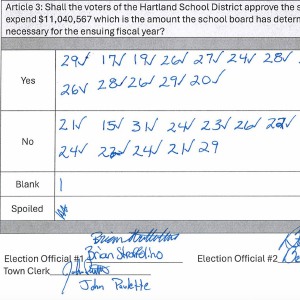 Hartland voters successfully petition for school budget revote
Hartland voters successfully petition for school budget revote 
